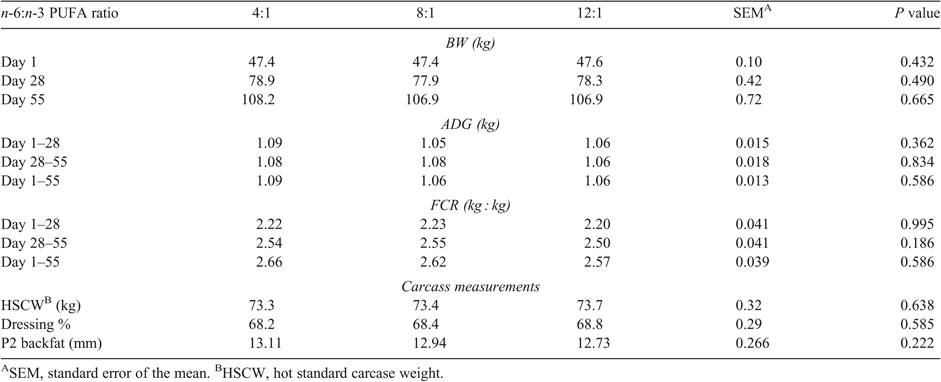Low to moderate dietary n-6:n-3 PUFA ratios do not affect performance of grower-finisher pigs
S. J. Wilkinson A D , B. P. Mullan B , J. C. Kim B and J. A. Downing CA Feedworks, Lancefield, VIC 3435.
B Department of Agriculture and Food Western Australia, South Perth, WA 6151.
C The University of Sydney, Camden, NSW 2570.
D Corresponding author. Email: stuart.wilkinson@feedworks.com.au
Animal Production Science 55(12) 1554-1554 https://doi.org/10.1071/ANv55n12Ab022
Published: 11 November 2015
Dietary fatty acids are potent mediators of physiological processes related to body composition and development. Previous findings by Wilkinson et al. (2014) identified that pigs fed diets with a high n-6:n-3 (24:1) polyunsaturated fatty acid (PUFA) ratio showed significantly reduced performance and increased health challenges when compared to pigs fed diets with moderate and low ratios of n-6:n-3 PUFA. Additionally, there is conjecture as to the effect of low n-6:n-3 PUFA ratios on the feed intake and growth performance of growing pigs. Despite the known physiological importance of n-6 and n-3 PUFA, no dietary recommendations for the n-6:n-3 PUFA ratio are available to pig nutritionists. This study investigated the effect of low to moderate n-6:n-3 PUFA ratios on the performance of grower-finisher pigs. It was hypothesised that feed intake and performance would be similar between groups fed low to moderate n-6:n-3 PUFA ratios.
A total of 430 gilts (Large White x Landrace x Duroc) with a body weight (BW) of 40 ± 0.2 kg (mean ± SD) were sourced from a high-health-status commercial herd. Pigs were individually ear tagged, weighed and randomly stratified to treatments based on BW. Pigs were housed in groups of seven with 12 replications per treatment and fed a standard commercial diet until an average pen weight of 45 kg was reached. Experimental diets, having, 4:1, 8 : 1 and 12 : 1 n-6:n-3 PUFA ratios, were fed for approximately 8 weeks. Diets were formulated to contain equivalent digestible energy (DE) (13.5 MJ/kg) and available lysine (0.6 g/MJ DE). Feed disappearance was measured using a Feedlogic system and individual BW was recorded weekly to calculate average daily gain (ADG) and feed conversion ratio (FCR). Carcass weight was recorded and depth of backfat (P2) measured using a Hennessy grading probe on the hot carcass between the 12th and 13th rib. Data were analysed by one-way ANOVA (Genstat, 15th Edition; UK).
There were no treatment differences in feed intake, growth and the carcass measurements (P > 0.05; Table 1). In accordance with the hypothesis, diets with n-6:n-3 PUFA ratios of less than 12 : 1 had no adverse effect on the feed intake and performance of grower-finisher pigs. These results are agreement with those reported by Wilkinson et al. (2014) where pigs fed low to moderate n-6:n-3 PUFA diets (<12:1) were not adversely affected. The effects of feeding higher ratios of n-6:n-3 PUFA (>12:1 n-6:n-3 PUFA) in grower-finisher pigs are currently being investigated.

|
References
Wilkinson SJ, Downing JA, Thomson PC, Newman RE (2014) Animal Production Science 54, 329–338.This project was funded by Australian Pork Limited.


